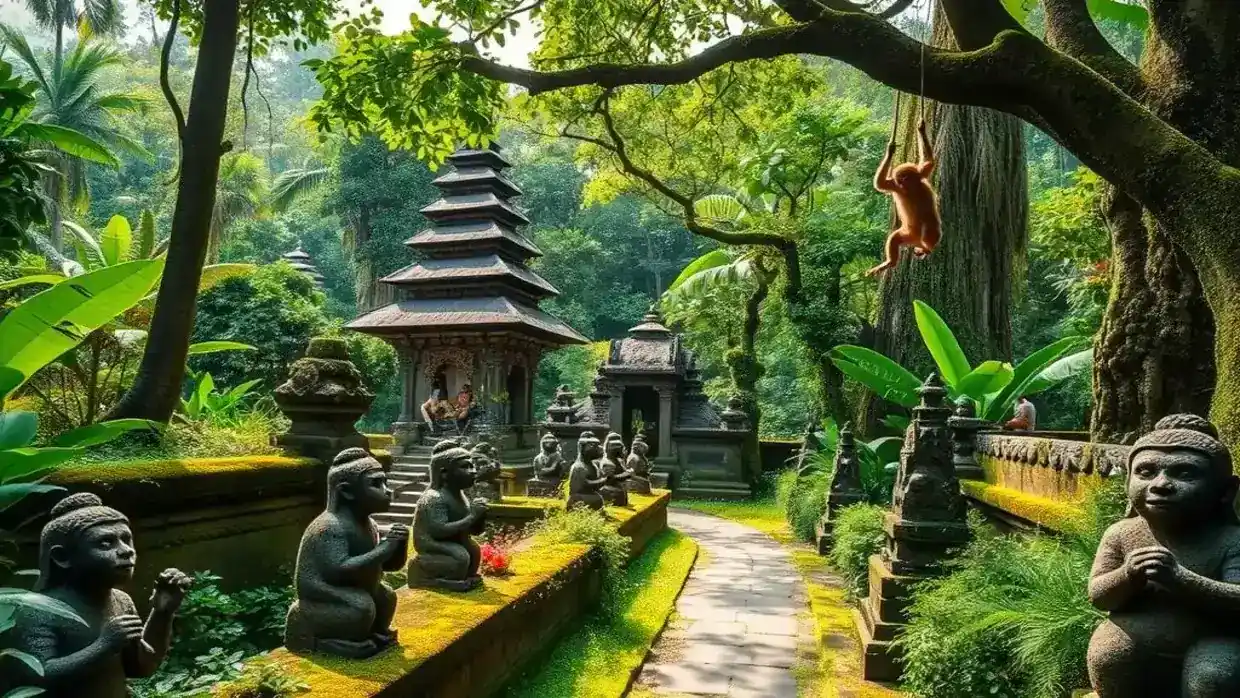
Sacred Monkey Forest Sanctuary Ubud: Nature’s Oasis
Discover the Sacred Monkey Forest Sanctuary in Ubud, Bali, Indonesia

Did you know the Sacred Monkey Forest Sanctuary in Ubud is huge, covering 30.8 acres? It draws about 10,000 visitors every month12. This place is a mix of nature, culture, and spirituality. It’s a top spot for travelers in Bali.
It’s home to over 600 playful long-tailed macaques. These animals make the visit special. The sanctuary also has three ancient temples, adding to the spiritual vibe. These temples show the balance between nature, humans, and the divine3.
Walking through, you’ll see over 186 tree species, many seen as sacred. The place is peaceful and beautiful2.
Key Takeaways
- The sanctuary spans 30.8 acres, providing a diverse ecosystem.
- It is home to approximately 600 macaques organized in different social groups.
- Three ancient temples within the forest date back to the 17th century.
- The Monkey Forest attracts around 10,000 visitors each month, showcasing its popularity.
- The entry fee is IDR 80,000 for adults and IDR 60,000 for children.
- Visitors can expect a daily opening from 8:30 AM to 6 PM.
Introduction to the Sacred Monkey Forest Sanctuary Ubud
The Sacred Monkey Forest Sanctuary in Ubud is a key part of Bali’s culture. It’s in the beautiful village of Padangtegal and covers about 28 acres. Over 10,000 tourists visit every month to see its beauty and wildlife45. This place is a key spot for protecting long-tailed macaques and has over 600 of them in groups5. It’s also home to 186 types of trees, making it a place full of life.
Since the 1930s, the sanctuary has been a big part of saving monkeys and teaching people about Bali’s nature4. It shows the deep connection between people, nature, and the spiritual world. The forest has three old Hindu temples from around 1350, adding to its history and spiritual feel4
Visitors love meeting the playful macaques and help with conservation by paying to enter. This helps keep the forest and its animals safe. The goal is to keep Bali’s culture and nature safe for the future45.
Location and Getting There
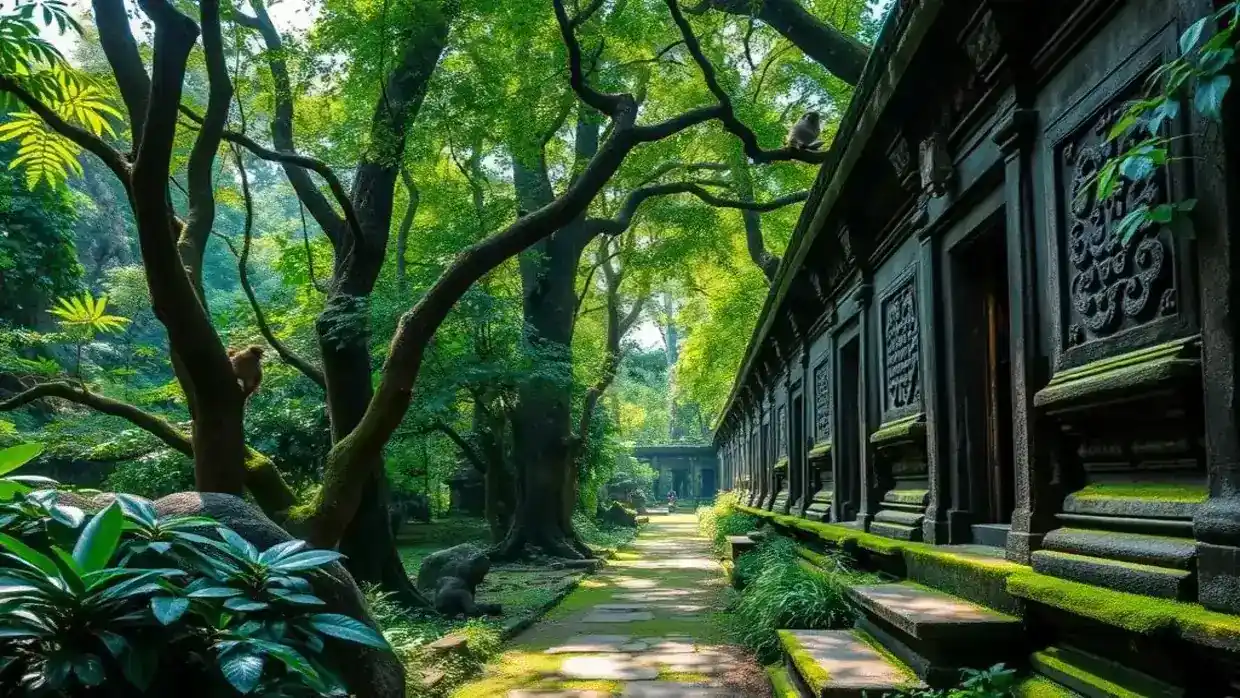
The Sacred Monkey Forest Sanctuary is just two kilometers from Ubud town’s heart. It’s easy to get there, especially by walking along Jalan Monkey Forest. Walking from the town center is nice, with shops and cafes along the way6.
When you arrive, you’ll see the magic of the lush greenery and playful monkeys6.
How to Reach the Sanctuary from Ubud Town
Getting to the sanctuary is easy from Ubud town. Walking is best if you’re nearby. It’s a two-kilometer walk that’s fun and scenic7.
The area is lively, with many shops and food stalls to see along the way7.
Transportation Options to the Monkey Forest
If walking isn’t your choice, there are other ways to get there. Taxis or apps like Gojek and Grab are good options. Renting a motorbike is also popular for exploring the area. For big groups, car rentals are a good idea. There’s plenty of parking near the Ubud Monkey Forest Sanctuary entrance.7.
Overview of the Monkey Forest in Ubud
Visiting the Ubud Monkey Forest lets you see a vibrant nature reserve. It’s famous for its beautiful views and important role in nature and culture. This place covers 12.5 hectares and has been a key conservation area since the 14th century. It’s home to over 1,260 Balinese long-tailed macaque monkeys, divided by age and where they live89.
Significance of the Forest as a Nature Reserve
The Ubud Monkey Forest is a key spot that draws 10,000 to 15,000 visitors every month8. It has about 186 plant and tree species, many of which are sacred in Balinese culture. This place is a safe space for a lively ecosystem810. It’s vital for people to help protect this place and its cultural history.
The Unique Ecosystem and Biodiversity
The sanctuary is full of over 115 tree species, showing its value to nature and culture10. The Ubud Monkey Forest is more than a monkey home; it’s a key place for many plants and animals. It supports research on animals and helps in saving nature10. This makes the Monkey Forest a key part of Bali’s natural treasures.
Macaques: The Residents of the Forest
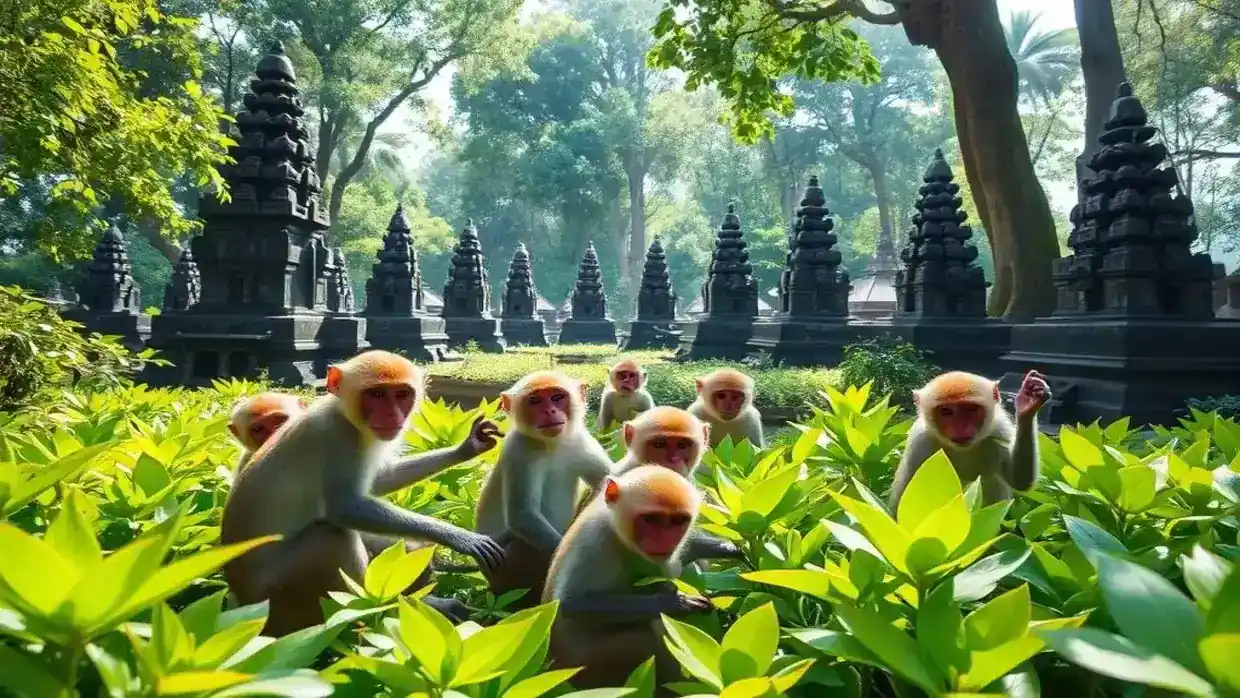
The Sacred Monkey Forest Sanctuary is home to fascinating macaques. The long-tailed and crab-eating macaques are key to the sanctuary’s ecosystem. Over 600 monkeys from four groups live here in the Bali Monkey Forest, surrounded by greenery and ancient temples.11.
Long-Tailed and Crab-Eating Macaques
In the Monkey Forest, I see long-tailed macaques being playful. They love to be around people and are fun to watch. Baby macaques play with their moms, making visitors smile as they see a monkey up close.12.
The crab-eating macaque is also a sight to see, searching for food by the river. These monkeys are important for the forest and help bring in tourists.
Behavior and Social Structure of the Monkeys
Macaques have complex social lives, with clear hierarchies. They groom and play with each other, showing their strong bonds12. But, they can get aggressive over food. This is why park rangers keep an eye on them to prevent fights12.
Every visit to the Monkey Forest teaches us more about their social ways. It’s a place where every trip is different and full of learning.
Sacred Monkey Forest Sanctuary Ubud: A Spiritual Space
The Sacred Monkey Forest Sanctuary is a mix of nature and spirituality, deeply tied to Balinese culture. Walking through its lush grounds, I feel a special energy. This place covers over 27 acres and is home to more than 605 long-tailed macaques13.
During my visit, I saw three ancient temples. They tell stories of the past and add to my cultural journey14. This place is not just for animals. It’s also a spot for people to meditate and connect with nature.
The sanctuary affects the local culture, teaching respect for nature and its spiritual side. I’ve seen visitors doing rituals, deepening their bond with Bali’s spiritual past. This place connects the world and the divine, showing the spiritual value in every part of the forest.
Temples Within the Sanctuary
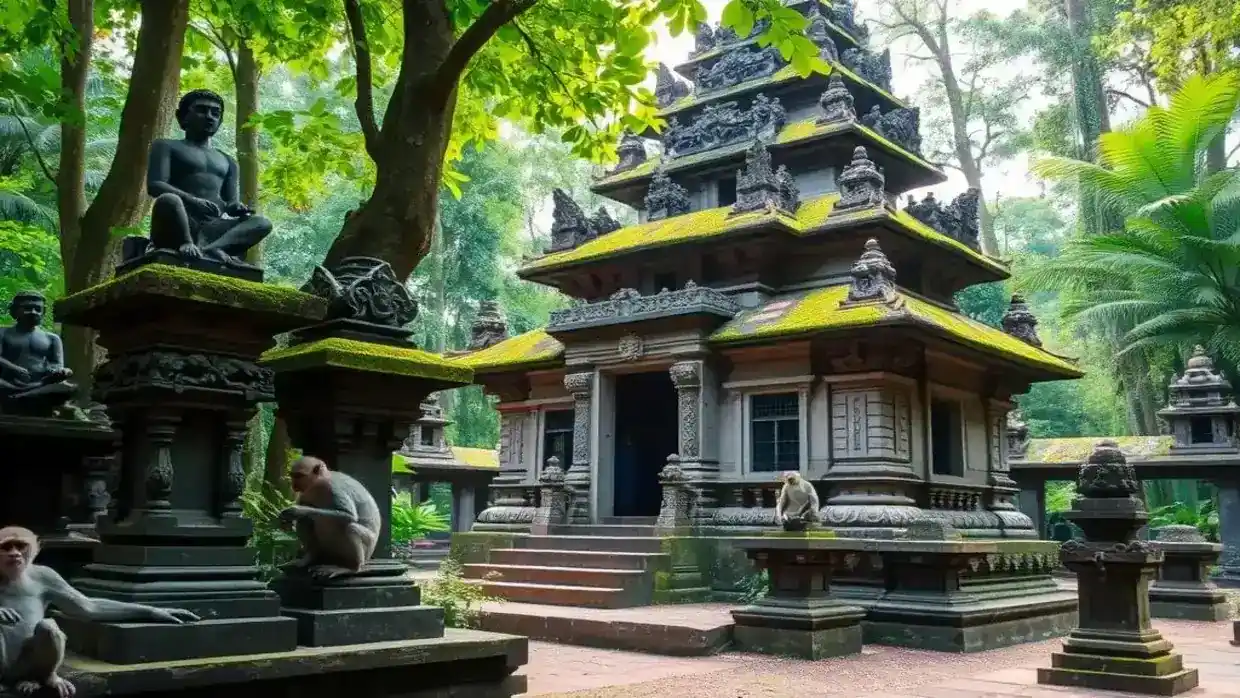
While exploring the Sacred Monkey Forest Sanctuary, I was amazed by the unique temples. They add to the area’s cultural beauty. Each temple is a place of worship and shows the deep Balinese spiritual heritage.
Pura Dalem Agung: The Main Temple
Pura Dalem Agung is the main temple in the sanctuary. It reflects the strong Hindu beliefs of the locals. This beautiful temple is dedicated to the god Shiva and has stunning architecture.
Visitors love the design, but they can’t go inside. This keeps the temple’s sacredness. The temple blends well with the greenery around it. It’s an important part of local culture and spiritual life. Monkeys also live around the temple, adding to the experience15.
Other Temple Complexes in the Forest
There are more temples in the sanctuary, showing the variety of Balinese religious practices. Pura Beji is one, where important rituals happen. These temples make the visit more spiritual and show the area’s cultural and religious importance in Bali.
The forest is a symbol of nature and spirituality living together. It’s a key place for those wanting to learn about Balinese culture16.
Nature Trails and Scenic Beauty
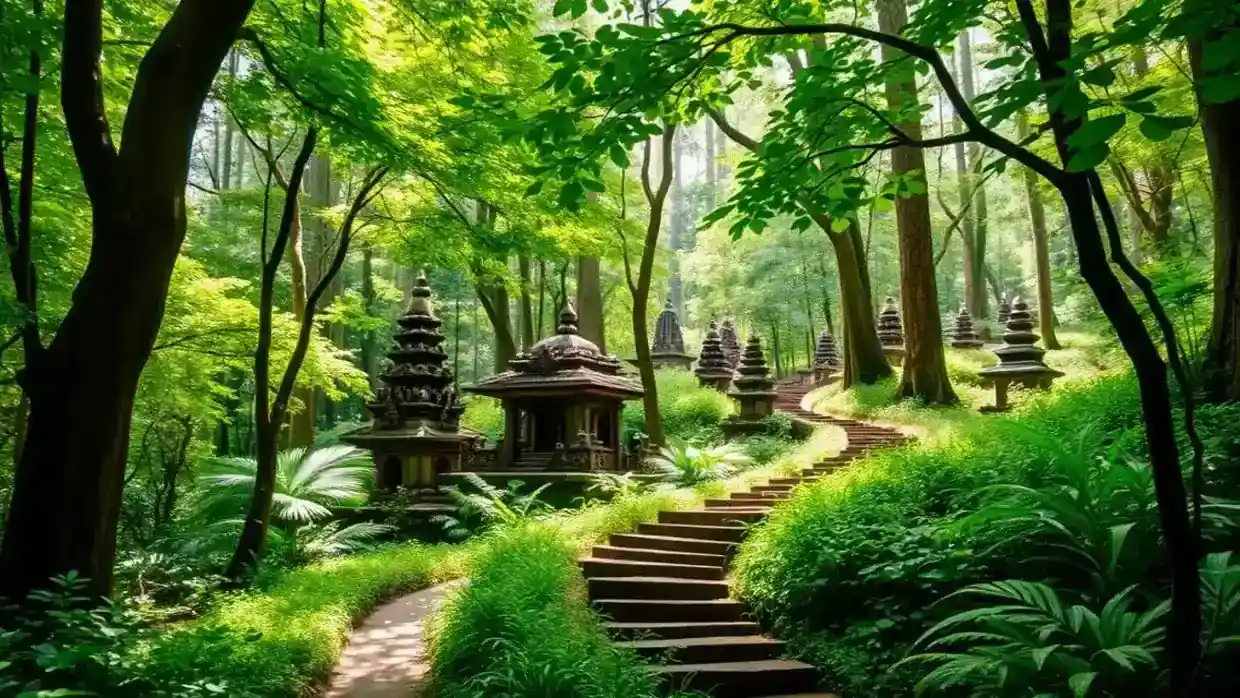
The Sacred Monkey Forest Sanctuary is a magical place for nature lovers. I can walk through beautiful nature trails surrounded by lush tropical trees. It covers about 27 acres and shows off Bali’s stunning nature with lots of different plants and a peaceful feel17.
As I walk, I feel calm and away from the busy world. The plants and quiet make me feel at peace.
Exploring the Lush Tropical Canopy
Walking the trails, I’m amazed by the big tropical trees that give shade and homes to animals. The paths go through an old forest with over 114 tree species18. Every turn shows a beautiful view, with bright greens and soft sunlight filtering through the trees.
Photography Opportunities in the Forest
This place is perfect for photographers like me, full of great shots to take. I can capture playful monkeys and beautiful temples surrounded by greenery. With the right light, I can make photos that will always remind me of my time in the Monkey Forest.17.
It’s also great for taking photos of the unique plants and animals. It’s a fun adventure for photographers in a peaceful setting.
Wildlife Conservation Efforts
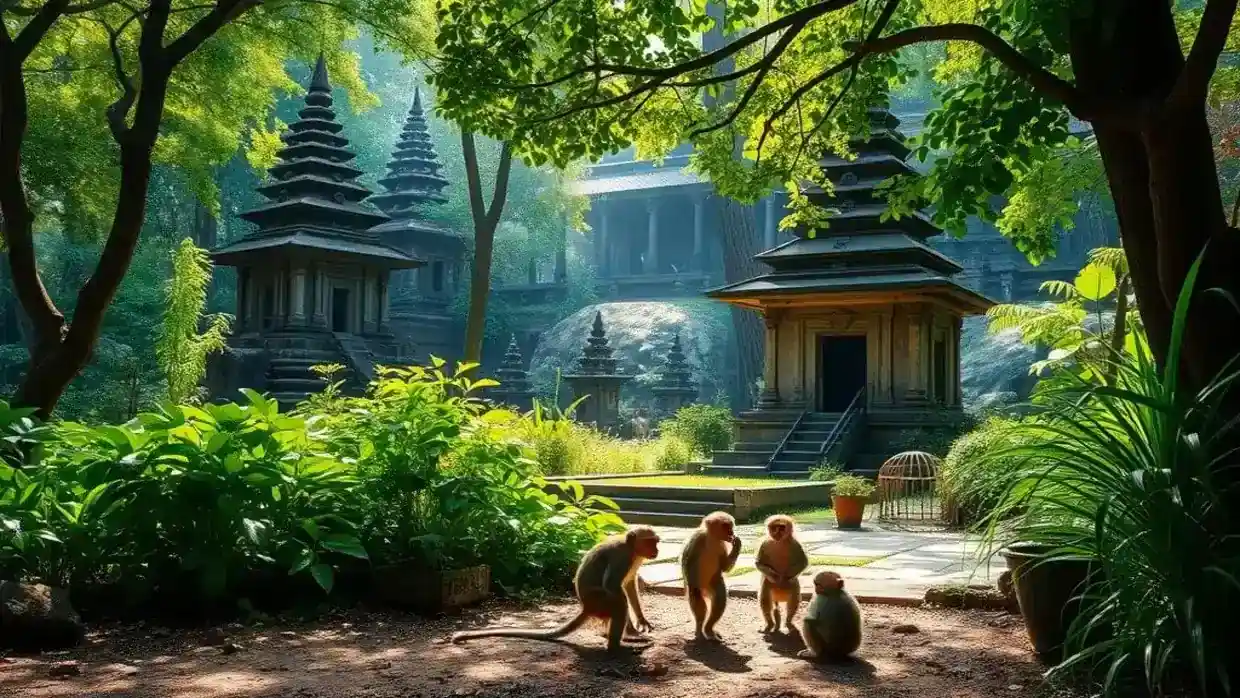
Visiting the Sacred Monkey Forest in Ubud shows how much people care about wildlife and animal welfare. It’s home to over 1,000 Balinese monkeys. They make sure these monkeys are healthy with regular check-ups and help programs19. This work helps keep the monkeys healthy and supports primate conservation in the area19.
Over 10,000 people visit every month, showing how much people care about wildlife19.
The Sanctuary’s Role in Animal Welfare
The Sacred Monkey Forest is a key place for animal welfare. It works on making sure animals are treated right and protected. They have many projects to make life better for the monkeys. This lets the community help and support these efforts.
Preservation of Rare Flora and Fauna
The Ubud Monkey Forest is more than a place for monkeys. It also works to save rare plants and animals. It covers about 27 acres and has around 186 tree species, adding to Bali’s biodiversity20. Keeping the environment healthy is key. It shows why saving natural habitats is important when human actions threaten wildlife.
Visitor Experience: What to Expect
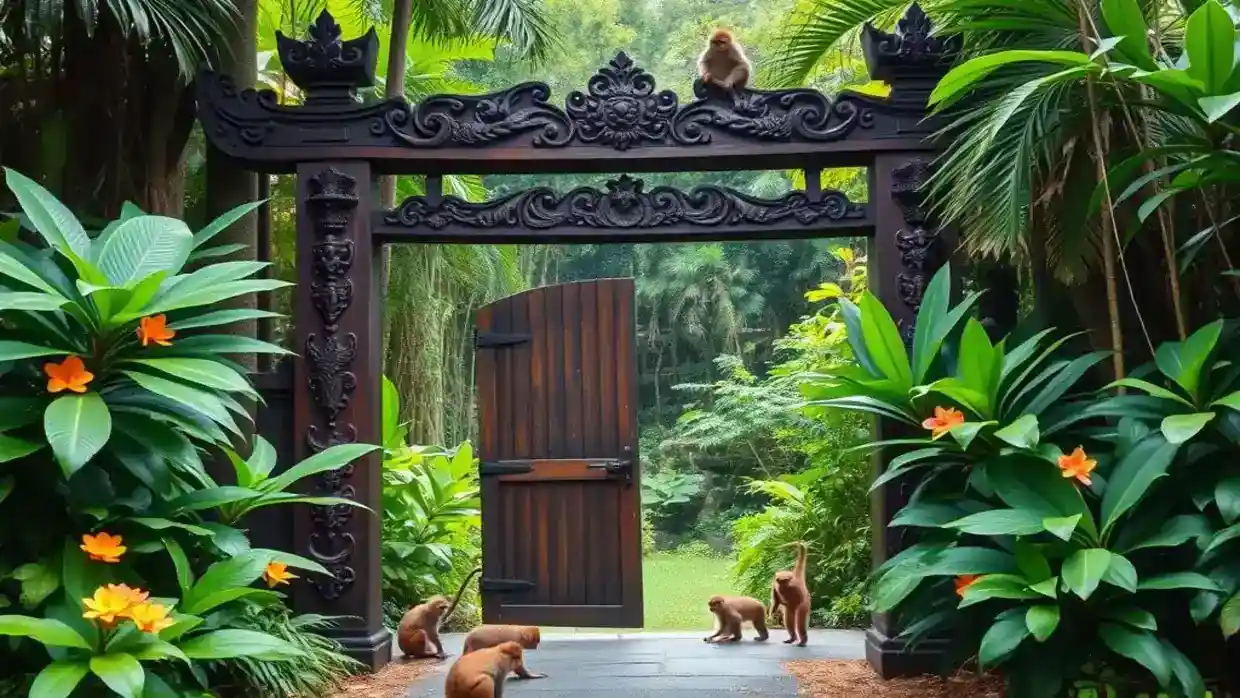
Visiting the Sacred Monkey Forest Sanctuary is a fun adventure. You can go from 8:30 AM to 6 PM every day. The entrance fee for adults is 80,000 IDR (about $5.50 USD) on weekdays and 100,000 IDR on weekends. This is a small price for such a magical place21
Opening Hours and Entrance Fees
The Sanctuary has three Hindu temples and is home to over 600 long-tailed macaques. It’s set in a beautiful area with more than 186 plant species21. Buying tickets early is a good idea, especially in June to August when it gets busy. Tickets are under $10 in U.S. currency, similar to a regular zoo visit22.
Time to Spend in the Monkey Forest
Spending 1.5 to 2 hours is perfect for exploring. You can walk the nature trails, watch the monkeys, and see the beautiful temples. Don’t forget to try local snacks at the canteens nearby, but leave your food at home to avoid trouble with the monkeys21.
Walking on the stone and wood paths, I felt closer to nature and the amazing animals around me. Just remember to keep your things close, as the curious monkeys might try to take your sunglasses or snacks.
Guidelines for Visiting the Monkey Forest
Visiting the Sacred Monkey Forest in Ubud is an unforgettable adventure. It’s key to follow certain rules to make sure we stay safe and the monkeys are happy. By being mindful of how we act, we help make the visit better for everyone.
Dos and Don’ts When Interacting with Monkeys
Here are some important tips for talking to monkeys at the Bali Monkey Forest:
- Do respect the monkeys’ space and avoid sudden moves.
- Don’t make loud noises or stare directly at them, as it can make them act out.
- Do keep your things close to stop monkeys from taking them.
- Don’t give the monkeys food, as it can make them act mean.
- Do stay calm if a monkey comes close, panicking can make things worse.
Safety Precautions to Follow
Your safety is the main concern at the Monkey Forest. The staff gives clear advice to keep our visits safe and fun:
- Always follow the sanctuary’s rules when with the monkeys.
- Be careful moving around and watch for monkeys nearby.
- If something goes wrong, there’s first aid on site for emergencies.
Feeding the Monkeys: Best Practices
At the Ubud Monkey Forest Sanctuary, feeding the macaques is done with care. They get bananas and sweet potatoes several times a day. This keeps them healthy and stops bad interactions with visitors23.
Allowed Foods for the Macaques
Only certain foods are given to the monkeys. The staff makes sure they get the right food to keep them healthy. They feed them on a regular schedule. This means visitors don’t have to worry about what to feed them. Experts take care of that.
Why Self-Feeding is Discouraged
Self-feeding is not allowed in the sanctuary. It can make the monkeys too dependent and lead to aggressive behavior. This harms their natural way of finding food and can cause fights. So, it’s important to put the monkeys’ needs first. This keeps everyone safe and happy23.
Best Time to Visit the Sacred Monkey Forest Sanctuary
Choosing the right time to visit the Sacred Monkey Forest Sanctuary makes your trip better. The dry season, from April to October, is best for nice weather and seeing the macaques. This time lets you see the 605 long-tailed macaques in their natural setting24.
Seasonal Considerations for Tourists
Think about how the season will affect your visit. Popular months bring more tourists, making it crowded. To avoid crowds, go early in the morning or late in the afternoon, like at 2:00 p.m. These times offer a peaceful visit and great photos because of the perfect light25.
Hours of Operation and Timing Tips
The sanctuary is open from 09:00 to 18:00, with ticket sales ending at 17:00. Weekdays are usually less busy, making your visit better. Visitors usually spend about 1 hour and 45 minutes here, using their time well24. Coming during off-peak times gives you a deeper connection with this special place.
Unique Experiences and Activities at the Sanctuary
Visiting the Sacred Monkey Forest Sanctuary is a treat. You can take monkey selfies, which are special for many. It’s fun to take photos with the playful monkeys, but remember to stay safe for everyone’s sake26.
The sanctuary is home to about 700 monkeys, making it lively and interactive26. You can buy bananas to feed them, with small bunches for Rp 20,000 and large bunches for Rp 50,00026. But, be careful as the monkeys can act fast.
Monkey Selfies: Capture the Moment
Monkey selfies are a hit with visitors. It’s important to follow the rules for these photos. Keep your things close, as the monkeys might take them if they can.
The best time for photos is early morning or late afternoon, when the light is great. Admission is Rp 50,000, giving you enough time to explore and take those selfies2627.
Exploring the Cultural Significance of the Forest
The cultural side of the Sacred Monkey Forest is just as important as the monkey fun. Learning about local customs and temple history makes my visit better. The sanctuary has three Hindu temples from around 1350, including Pura Dalem Agung for spiritual and community activities18.
Seeing these traditions helps me appreciate Bali’s culture more. Each temple shows the island’s deep spiritual bond with its history. It lets visitors like me dive into the area’s rich heritage.
Nearby Attractions and Activities in Ubud
Ubud is full of life with many things to see and do. The Ubud Palace is a key spot, showing off Bali’s royal past. Art galleries around town display beautiful traditional and modern art.
Walking through the green rice fields is a treat. It shows off Ubud’s stunning nature.
Pura Tirta Empul is famous for its holy water and peaceful vibe. It costs 50,000 IDR (about 3.30 USD) to get in28. The Tegenungan Waterfall is also close by, with a fee of 15,000 IDR (1 USD)28. These places add a lot to my Ubud trip, mixing nature with culture.
For a full Ubud experience, consider a guided tour. These tours cost between 30-60 AUD (20-40 USD) and let you see the area with experts29. Plus, staying in Ubud is affordable, with hostels starting at 6 AUD per night29.
Conclusion
My trip to the Sacred Monkey Forest Sanctuary in Ubud was amazing. It was a mix of nature and spirituality. The place is about 27 acres big and has over 700 long-tailed macaques. You can see these fun animals in their home3031.
It costs IDR 50,000 for adults and IDR 40,000 for kids to get in. This makes it easy for everyone to enjoy. It’s a great way to see more of Bali3132.
Walking through, I felt close to nature and the area’s spirituality. There are old temples here from the 14th century32. The forest is full of over 115 tree species, making it a special place for many animals32.
It’s important to follow the rules to keep everyone safe and happy. This shows we respect the monkeys and their home.
At the end, I saw that the sanctuary is more than just animals. It’s a deep dive into Balinese culture. You can enjoy festivals and see local crafts at the Ubud Art Market. I think you should definitely visit the Sacred Monkey Forest Sanctuary. It’s a unique mix of nature and spirituality.
Frequently Asked Questions
Q: What is the Sacred Monkey Forest Sanctuary in Ubud, Bali?
A: The Sacred Monkey Forest Sanctuary is a nature reserve and a temple complex in Ubud, Bali, Indonesia. It is home to a large population of monkeys, specifically the long-tailed macaques, and features beautiful forested areas, sacred temples, and walking paths.
Q: How can I get to the Sacred Monkey Forest in Ubud?
A: To get to the Sacred Monkey Forest, you can take a taxi or scooter from anywhere in Ubud town. It is conveniently located near many attractions in Bali and is easily accessible for visitors.
Q: What should I know before I go to the Ubud Monkey Forest?
A: Before visiting the monkey forest, it’s important to know that you should not bring food or shiny objects, as monkeys may try to take them. Be cautious when interacting with the monkeys in Ubud town, and avoid direct eye contact to prevent any aggressive behavior.
Q: Is there an entrance ticket for the Sacred Monkey Forest Ubud?
A: Yes, there is an entrance ticket required to enter the Sacred Monkey Forest Sanctuary. The ticket price is affordable and supports the maintenance of the monkey sanctuary and the surrounding forest area.
Q: Can I see monkeys up close in the monkey forest grounds?
A: Yes, visitors can see monkeys up close throughout the monkey forest grounds. The monkeys are accustomed to human presence and often approach visitors, making it a great opportunity for a monkey selfie!
Q: What can I expect to see in the Sacred Monkey Forest Ubud?
A: In addition to the monkeys, the Sacred Monkey Forest features beautiful temples like Pura Dalem Agung Padangtegal, lush greenery, and ancient stone sculptures. It is a serene place in Bali that offers a unique experience of nature and culture.
Q: How long should I plan to spend at the Ubud Monkey Forest?
A: Most visitors spend about 1 to 2 hours exploring the monkey forest. This allows ample time to see monkeys, visit the temples, and walk through the scenic forest area.
Q: Are there other monkey forests near Ubud?
A: Yes, besides the Sacred Monkey Forest Ubud, there are other monkey forests in Bali, such as the Sangeh Monkey Forest and Alas Kedaton Monkey Forest, which also offer opportunities to see monkeys in a more natural habitat.
Q: Is the Sacred Monkey Forest a sacred place?
A: Yes, the Sacred Monkey Forest is considered a sacred place by the local Balinese people. It is not only a sanctuary for monkeys but also a spiritual site featuring a Hindu temple complex where rituals and ceremonies are held.
Q: What should I know before I go to the Sacred Monkey Forest Sanctuary in Ubud?
A: Before visiting, it’s essential to understand the rules regarding interaction with the monkeys, as they can be unpredictable. It’s advisable to keep your belongings secure as the monkeys are known to steal items. Also, consider the best times to visit to avoid crowds and ensure a more enjoyable experience.
Q: Where do the monkeys live in the monkey forest?
A: The monkeys in the Ubud Monkey Forest primarily inhabit the forest area surrounding the sacred place. This lush environment provides them with food, shelter, and a natural habitat to thrive.
Q: What is the best time to spend in the monkey forest?
A: The best time to spend in the monkey forest is during the early morning or late afternoon when the weather is cooler, and the monkeys are more active. This also helps you avoid the peak visiting hours.
Q: What attractions can I see while visiting Ubud?
A: While visiting Ubud, you can explore other attractions like the Pura Dalem Agung Padangtegal, which is a significant temple within the monkey forest. Additionally, the surrounding area offers art galleries, rice terraces, and local markets.
Q: Are there any risks of monkey bites in the monkey sanctuary?
A: Yes, there is a risk of monkey bites in the monkey sanctuary. It’s crucial to maintain a safe distance and not provoke the monkeys. If bitten, seek medical attention promptly as rabies can be a concern.
Q: Can I take photos with the monkeys in Ubud?
A: Yes, you can take photos with the monkeys, including the popular monkey selfie. However, be cautious and avoid feeding or startling them to ensure both your safety and that of the monkeys.
Q: How do I enter the monkey forest?
A: To enter the monkey forest, you need to purchase an entrance ticket at the entrance. The tickets help maintain the sanctuary and its conservation efforts. Make sure to check the opening hours before your visit.
Q: What should I do if a monkey steals my belongings in the monkey place?
A: If a monkey steals your belongings, remain calm and do not chase after the monkey. Instead, try to distract it with food or a toy that you can share, but avoid any aggressive actions. It’s best to secure your items before entering the monkey forest grounds.
Q: Is the Sacred Monkey Forest Sanctuary suitable for families visiting Bali?
A: Yes, the Sacred Monkey Forest Sanctuary is suitable for families vacationing in Bali. It offers a unique opportunity to see monkeys in their natural habitat while also providing educational insights about the local ecosystem and culture.
Source Links
- https://www.saltinourhair.com/bali/ubud-monkey-forest/
- https://www.knowstoneunturned.org/blog/2017/3/25/ubuds-sacred-monkey-forest-what-to-expect-yf2py
- https://www.bali.info/en/monkey-forest-in-ubud-sacred-monkey-forest/
- https://villaamrita.com/monkey-forest-ubud-in-bali/
- https://www.minoritynomad.com/blog/only-reason-to-visit-ubud-sacred-monkey-forest-sanctuary
- https://monkeyforestubud.com/visit/
- https://www.acouplescalling.com/the-sacred-monkey-forest-sanctuary-in-ubud/
- https://en.wikipedia.org/wiki/Ubud_Monkey_Forest
- https://whatkirstydidnext.com/travel/visiting-the-sacred-monkey-forest-sanctuary-in-ubud/
- https://monkeyforestubud.com/about-us/
- https://nerdnomads.com/monkey-forest-ubud-bali
- https://www.tomvierus.com/blog/travel/the-macaques-in-ubud-the-monkey-forest-from-a-photography-perspective
- https://finnsbeachclub.com/guides/monkey-forest-ubud/
- https://ladyhattan.com/ubud-bali-indonesia-inside-sacred-monkey-forest-sanctuary/
- http://www.ubudmonkeyforest.com/
- https://www.ramblynjazz.com/post/monkey-business-a-visit-to-ubud-s-famous-sanctuary
- https://baligram.me/blog/ubud-monkey-forest-sanctuary-a-sacred-place-where-monkeys-rule
- https://www.travelphotographyguru.com/travel-blogs/sacred-monkey-forest-sanctuary
- https://foreverbreak.com/travel/indonesia/bali/ubud/sacred-monkey-forest-sanctuary/
- https://woodsbali.com/blog/primates-nature-and-culture-ubud-monkey-forest/
- https://theadventuremanual.com/monkey-forest-ubud/
- https://sandsunandmessybuns.com/visit-monkey-forest-sanctuary/
- https://fallontravels.com/blog/monkey-forest-ubud
- https://www.raftingbali.net/monkey-forest-ubud/
- https://balicheapesttours.com/ubud-monkey-forest.html
- https://www.thetravelpockets.com/new-blog/monkey-forest-ubud-bali
- https://www.divergenttravelers.com/ubud-monkey-forest/
- https://www.saltinourhair.com/bali/things-to-do-ubud/
- https://budgettravelwithgabby.com/how-to-visit-ubud-on-a-budget/
- https://steemit.com/travel/@timsaid/timtravels-review-of-the-sacred-monkey-forest-sanctuary-ubud
- https://www.tripoto.com/ubud/places-to-visit/sacred-monkey-forest-sanctuary
- https://www.ubudkayahouse.com/article/monkey-forest-ubud